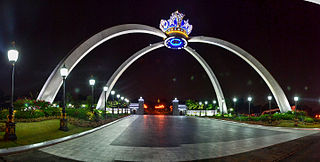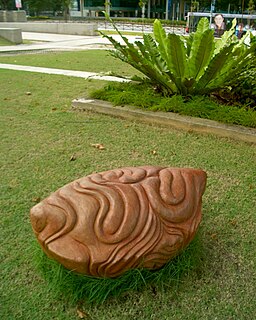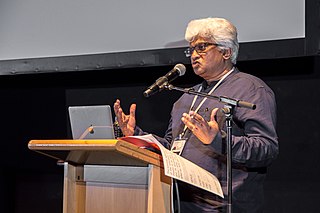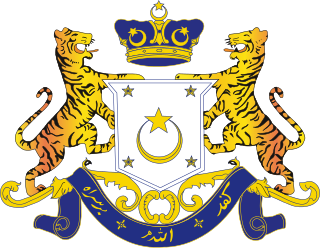Paul Soldner was an American ceramic artist, noted for his experimentation with the 16th-century Japanese technique called raku, introducing new methods of firing and post firing, which became known as American Raku.
The Cultural Medallion is a Singapore cultural award conferred to those who have achieved artistic excellence in dance, theatre, literature, music, photography, art and film. It is widely recognized as Singapore's pinnacle arts award.
Studio pottery is pottery made by professional and amateur artists or artisans working alone or in small groups, making unique items or short runs. Typically, all stages of manufacture are carried out by the artists themselves. Studio pottery includes functional wares such as tableware and cookware, and non-functional wares such as sculpture. Studio potters can be referred to as ceramic artists, ceramists, ceramicists or as an artist who uses clay as a medium. Much studio pottery is tableware or cookware, but an increasing number of studio potters produce non-functional or sculptural items. In Britain since the 1980s, there has been a distinct trend away from functional pottery, for example, the work of artist Grayson Perry. Some studio potters now prefer to call themselves ceramic artists, ceramists or simply artists. Studio pottery is represented by potters all over the world and has strong roots in Britain. Art pottery is a related term, used by many potteries from about the 1870s onwards, in Britain and America; it tends to cover larger workshops, where there is a designer supervising the production of skilled workers who may have input into the pieces made. The heyday of British and American art pottery was about 1880 to 1940.

The Singapore Art Museum is an art museum located in the Downtown Core district of Singapore. Formerly a 19th-century Catholic school, it is the first fully dedicated contemporary visual arts museum in Singapore with one of the world’s most important collections by local, Southeast and East Asian artists. It collaborates with international art museums to co-curate contemporary art exhibitions.

The National Arts Council of Singapore is a statutory board established on 15 October 1991 to oversee the development of arts in Singapore. It is under the purview of the Ministry of Culture, Community and Youth. The NAC provides grants, scholarships, awards and platforms for arts practitioners, as well as arts education and programmes for the general public.

Istana Bukit Serene is the royal palace and official residence of the Sultan of Johor, located in Johor Bahru, Malaysia. The palace faces the Straits of Johor and has a bird's eye view of Singapore, a former possession of the Sultanate.
Ong Keng Sen is a Singaporean director of the theatre group TheatreWorks, which was founded in 1985.

João Edmundo Lemos Carqueijeiro was born in Lobito, Angola on 25 February 1954. He is a Portuguese plastic artist.
Steve Heinemann is a Canadian artist working in ceramics.
DUO is a contemporary twin-tower integrated mixed-use development located on a site bordered by Ophir Road, Rochor Road and Beach Road in Singapore.

Ng Eng Teng, The Grandfather of Singapore Sculpture was a sculptor in Singapore known for his figurative sculptures, many of which are found in public locations around Singapore. His legacy include the Mother And Child bronze sculpture outside Far East Shopping Centre along Orchard Road, and The Explorer located at the entrance of the Singapore Art Museum.

Kintsugi, also known as kintsukuroi, is the Japanese art of repairing broken pottery by mending the areas of breakage with lacquer dusted or mixed with powdered gold, silver, or platinum, a method similar to the maki-e technique. As a philosophy, it treats breakage and repair as part of the history of an object, rather than something to disguise.

Han Sai Por is a Singaporean sculptor. A graduate of the Nanyang Academy of Fine Arts (NAFA), East Ham College of Art, Wolverhampton College of Art and Lincoln University, New Zealand, she worked as a teacher and later as a part-time lecturer at NAFA, the LASALLE-SIA College of the Arts, and the National Institute of Education, Nanyang Technological University, before becoming a full-time artist in 1997.
Heart of God Church, abbreviated as HOGC, is a non-denominational church in Singapore. It was founded by husband and wife Tan Seow How and Cecilia Chan, more commonly known as Pastor How and Pastor Lia, in 1999. The church currently holds its services in Paya Lebar in eastern Singapore. The church has a strong community built for youth members. It has maintained a young demographic with an average age of 22 across the church.

Thirunalan Sasitharan is a Singaporean theatre educator and the co-founder and director of Intercultural Theatre Institute (ITI), formerly known as the Theatre Training & Research Programme (TTRP).
Walter Gibson Dexter, R.C.A. was a Canadian ceramic artist, pottery artist and post-secondary ceramic art educator.
Robin Hopper was a Canadian ceramist, potter, teacher, author, garden designer and arts activist.

Tunku Abdul Jalil Iskandar ibni Sultan Ibrahim Ismail was the Tunku Laksamana of Johor. He was born to members of the Johor Royal Family and the Perak Royal Family.
Harris Deller is an American ceramist.








